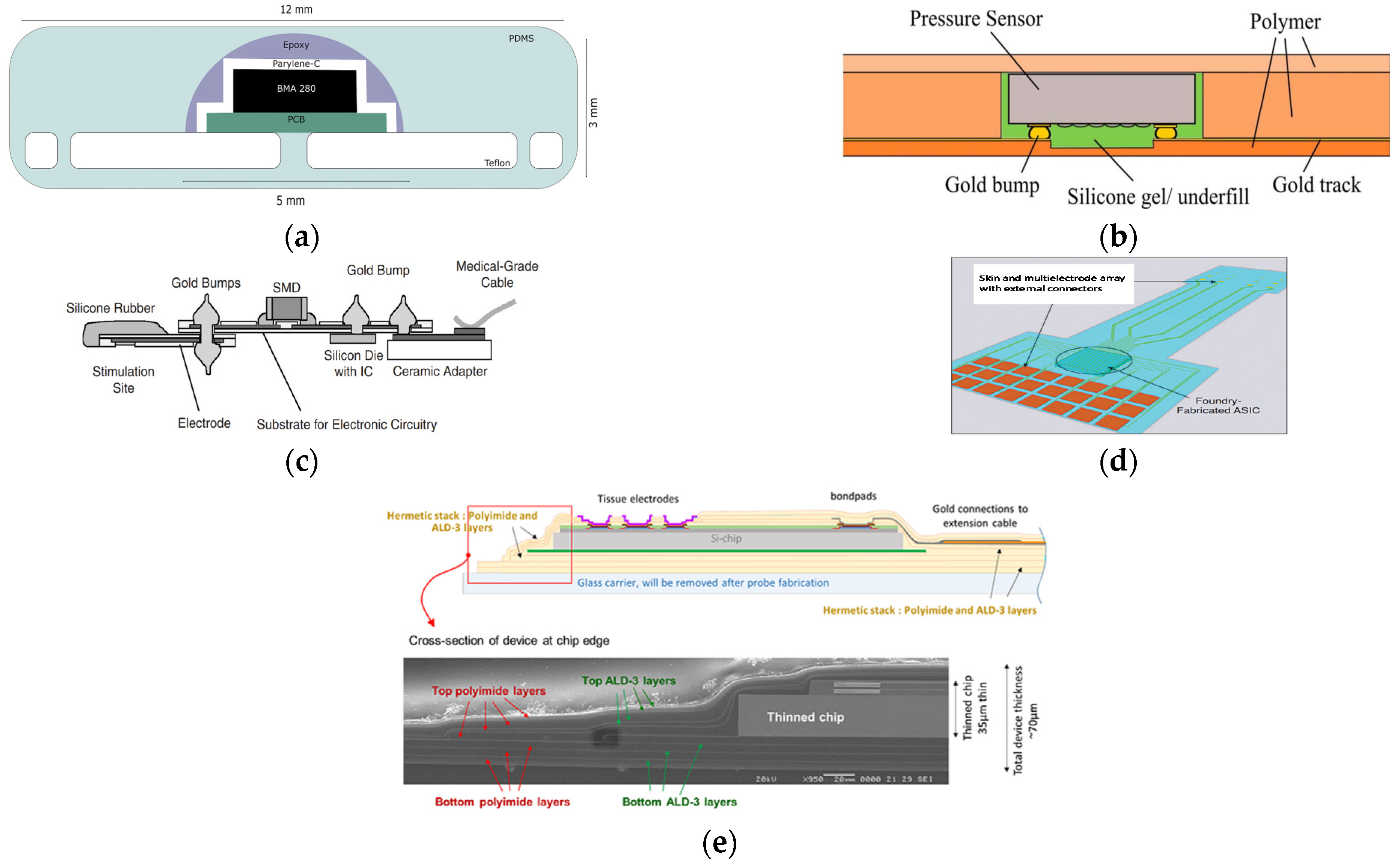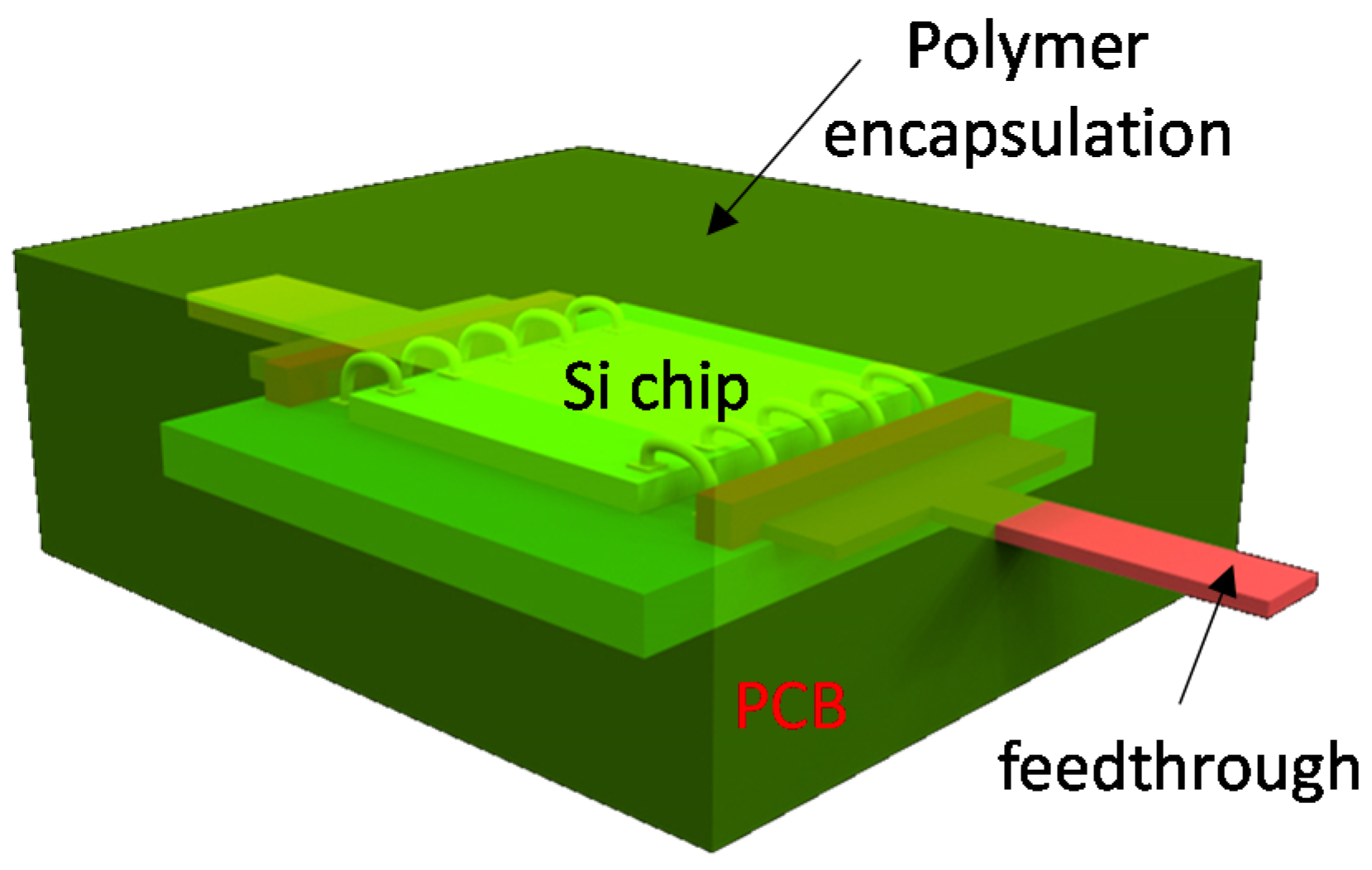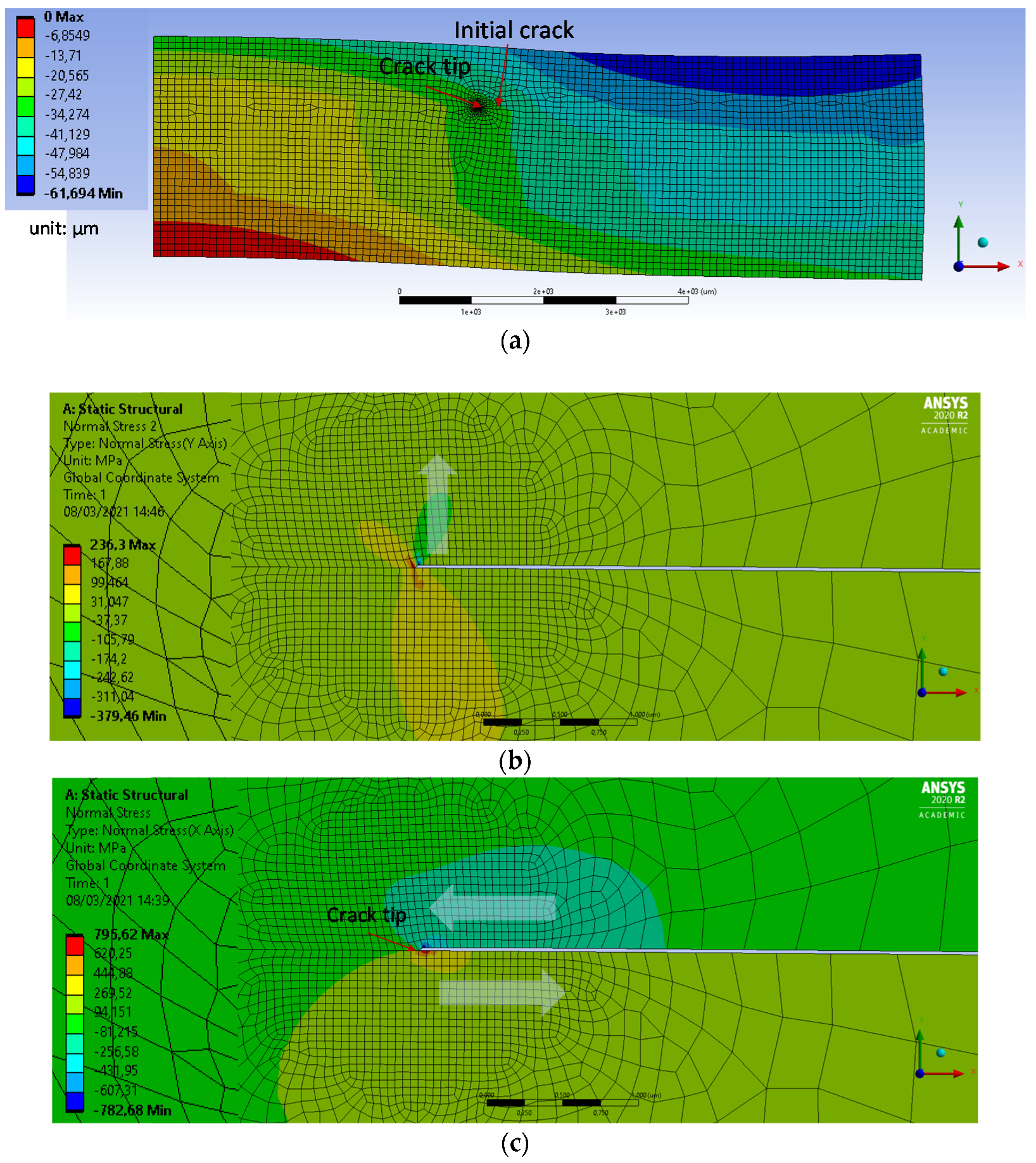Polymer-Based Biocompatible Packaging for Implantable Devices: Packaging Method, Materials, and Reliability Simulation
Abstract
1. Introduction
2. Biocompatible Packaging Methods
2.1. Polymer Encapsulation
2.2. Chip-Level Packaging
3. Reliability of Biocompatible Package
3.1. Estimation of Package Life-Time through Acceleration Aging Test
3.2. Interfacial Fracture Mechanics
3.3. FEM Simulation of a Biocompatible Package
4. Conclusions
Funding
Conflicts of Interest
References
- Lee, D.U.; Kim, K.W.; Kim, K.W.; Kim, H.; Kim, J.Y.; Park, Y.J.; Kim, J.H.; Kim, D.S.; Park, H.B.; Shin, J.W.; et al. 25.2 A 1.2 V 8 Gb 8-channel 128 GB/s high-bandwidth memory (HBM) stacked DRAM with effective microbump I/O test methods using 29 nm process and TSV. In Proceedings of the 2014 IEEE International Solid-State Circuits Conference Digest of Technical Papers (ISSCC), San Francisco, CA, USA, 9–13 February 2014; pp. 432–433. [Google Scholar]
- Jun, H.; Cho, J.; Lee, K.; Son, H.-Y.; Kim, K.; Jin, H.; Kim, K. HBM (High Bandwidth Memory) DRAM Technology and Architecture. In Proceedings of the 2017 IEEE International Memory Workshop (IMW), Monterey, CA, USA, 14–17 May 2017; pp. 1–4. [Google Scholar]
- Jun, H.; Nam, S.; Jin, H.; Lee, J.-C.; Park, Y.J.; Lee, J.J. High-Bandwidth Memory (HBM) Test Challenges and Solutions. IEEE Des. Test 2016, 34, 16–25. [Google Scholar] [CrossRef]
- Kim, S.; Kim, S.; Cho, K.; Shin, T.; Park, H.; Lho, D.; Park, S.; Son, K.; Park, G.; Kim, J. Processing-in-memory in High Bandwidth Memory (PIM-HBM) Architecture with Energy-efficient and Low Latency Channels for High Bandwidth System. In Proceedings of the 2019 IEEE 28th Conference on Electrical Performance of Electronic Packaging and Systems (EPEPS), Montreal, QC, Canada, 6–9 October 2019; pp. 1–3. [Google Scholar]
- Kim, S.J.; Lee, D.S.; Kim, I.G.; Sohn, D.W.; Park, J.Y.; Choi, B.K.; Kim, S.W. Evaluation of the biocompatibility of a coating mate-rial for an implantable bladder volume sensor. Kaohsiung J. Med. Sci. 2012, 28, 123–129. [Google Scholar] [CrossRef] [PubMed]
- Teo, A.; Mishra, A.; Park, I.; Kim, Y.J.; Park, W.-T.; Yoon, Y.-J. Polymeric Biomaterials for Medical Implants and Devices. ACS Biomater. Sci. Eng. 2016, 2, 454–472. [Google Scholar] [CrossRef] [PubMed]
- Pérez-Merino, P.; Dorronsoro, C.; Llorente, L.; Durán, S.; Jiménez-Alfaro, I.; Marcos, S. In vivo chromatic aber-ration in eyes implanted with intraocular lenses. Invest. Ophthalmol. Vis. Sci. 2013, 54, 2654–2661. [Google Scholar] [CrossRef] [PubMed][Green Version]
- Kirsten, S.; Uhlemann, J.; Braunschweig, M.; Wolter, K.J. Packaging of electronic devices for long-term implan-tation. In Proceedings of the 35th International Spring Seminar on Electronics Technology (ISSE), Bad Aussee, Austria, 9–13 May 2012; IEEE: Piscataway, NJ, USA, 2012; pp. 123–127. [Google Scholar]
- Hogg, A.; Aellen, T.; Uhl, S.; Graf, B.; Keppner, H.; Tardy, Y.; Burger, J. Ultra-thin layer packaging for implanta-ble electronic devices. J. Micromech. Microeng. 2013, 23, 075001. [Google Scholar] [CrossRef]
- Hassler, C.; von Metzen, R.P.; Ruther, P.; Stieglitz, T. Characterization of parylene C as an encapsulation mate-rial for implanted neural prostheses. J. Biomed. Mater. Res. Part B 2010, 93, 266–274. [Google Scholar]
- Lee, S.W.; Min, K.S.; Jeong, J.; Kim, J.; Kim, S.J. Monolithic Encapsulation of Implantable Neuroprosthetic Devices Using Liquid Crystal Polymers. IEEE Trans. Biomed. Eng. 2011, 58, 2255–2263. [Google Scholar] [CrossRef]
- Min, K.S.; Lee, C.J.; Jun, S.B.; Kim, J.; Lee, S.E.; Shin, J.; Chang, J.W.; Kim, S.J. A Liquid Crystal Polymer-Based Neuromodulation System: An Application on Animal Model of Neuropathic Pain. Neuromodul. Technol. Neural Interface 2013, 17, 160–169. [Google Scholar] [CrossRef] [PubMed]
- Kramar, T.; Michalec, I.; Kovacocy, P. The laser beam welding of titanium grade 2 alloy. GRANT J. 2012, 1, 77–79. [Google Scholar]
- Schuettler, M.; Ordonez, J.S.; Santisteban, T.S.; Schatz, A.; Wilde, J.; Stieglitz, T. Fabrication and test of a hermetic miniature implant package with 360 electrical feedthroughs. In Proceedings of the 2010 Annual International Conference of the IEEE Engineering in Medicine and Biology, Buenos Aires, Argentina, 31 August–4 September 2010; pp. 1585–1588. [Google Scholar] [CrossRef]
- Chlebowski, A.L.; Chow, E.Y.; Ellison, C.; Irazoqui, P.P. Integrated LTCC packaging for use in biomedical devices. Bio-Med Mater. Eng. 2012, 22, 361–372. [Google Scholar] [CrossRef]
- Op de Beeck, M.; O’Callaghan, J.; Qian, K.; Malachowski, K.; Vanfleteren, J.; Van Hoof, C. Biocompatible packaging solutions for implantable electronic systems for medical applications. In Proceedings of the IEEE Circuits and Systems Society Forum on Emerging and Selected Topics, Seoul, Korea, 20 May 2012. [Google Scholar]
- Brancato, L.; Weydts, T.; Oosterlinck, W.; Herijgers, P.; Puers, R. Biocompatible packaging of an epicardial accel-erometer for real-time assessment of cardiac motion. Procedia Eng. 2016, 168, 80–83. [Google Scholar] [CrossRef]
- Brancato, L.; Weydts, T.; De Clercq, H.; Dimiaux, T.; Herijgers, P.; Puers, R. Biocompatible Packaging and Testing of an Endocardial Accelerometer for Heart Wall Motion Analysis. Procedia Eng. 2015, 120, 840–844. [Google Scholar] [CrossRef]
- Kirsten, S.; Schubert, M.; Braunschweig, M.; Woldt, G.; Voitsekhivska, T.; Wolter, K.-J. Biocompatible packaging for implantable miniaturized pressure sensor device used for stent grafts: Concept and choice of materials. In Proceedings of the 2014 IEEE 16th Electronics Packaging Technology Conference (EPTC), Singapore, 3–5 December 2014; pp. 719–724. [Google Scholar]
- Velten, T.; Ruf, H.; Barrow, D.; Aspragathos, N.; Lazarou, P.; Jung, E.; Malek, C.; Richter, M.; Kruckow, J.; Wackerle, M. Packaging of bio-MEMS: Strategies, technologies, and applications. IEEE Trans. Adv. Packag. 2005, 28, 533–546. [Google Scholar] [CrossRef]
- Meyer, J.-U.; Stieglitz, T.; Scholz, O.; Haberer, W.; Beutel, H. High density interconnects and flexible hybrid assemblies for active biomedical implants. IEEE Trans. Adv. Packag. 2001, 24, 366–374. [Google Scholar] [CrossRef]
- Stieglitz, T.; Schuetter, M.; Koch, K.P. Implantable biomedical microsystems for neural prostheses. IEEE Eng. Med. Boil. Mag. 2005, 24, 58–65. [Google Scholar] [CrossRef] [PubMed]
- Rodger, D.C.; Tai, Y.-C. Microelectronic packaging for retinal prostheses. IEEE Eng. Med. Boil. Mag. 2005, 24, 52–57. [Google Scholar] [CrossRef] [PubMed]
- De Beeck, M.O.; Verplancke, R.; Schaubroeck, D.; Cuypers, D.; Cauwe, M.; Vandecasteele, B.; O’Callaghan, J.; Braeken, D.; Andrei, A.; Firrincieli, A.; et al. ltra-thin biocompatible implantable chip for bidirectional communication with peripheral nerves. In Proceedings of the 2017 IEEE Biomedical Circuits and Systems Conference, Turin, Italy, 19–21 October 2017; pp. 1–4. [Google Scholar]
- Barz, F.; Lausecker, R.; Wallrabe, U.; Ruther, P.; Paul, O. Wafer-level shellac-based interconnection process for ultrathin silicon chips of arbitrary shape. In Proceedings of the 2016 IEEE 29th International Conference on Micro Electro Mechanical Systems (MEMS), Shanghai, China, 24–28 January 2016; pp. 520–523. [Google Scholar] [CrossRef]
- Biran, R.; Martin, D.C.; Tresco, P.A. The brain tissue response to implanted silicon microelectrode arrays is increased when the device is tethered to the skull. J. Biomed. Mater. Res. 2007, 82, 169. [Google Scholar] [CrossRef]
- Du, Z.J.; Kolarcik, C.L.; Kozai, T.D.; Luebben, S.D.; Sapp, S.A.; Zheng, X.S.; Nabity, J.A.; Cui, X.T. Ultrasoft microwire neural electrodes improve chronic tissue integration. Acta Biomater. 2017, 53, 46–58. [Google Scholar] [CrossRef] [PubMed]
- Inmann, A.; Hodgins, D. Implantable Sensor Systems for Medical Applications; Woodhead Publishing Series in Biomaterials; Elsevier: Amsterdam, The Netherlands, 2013. [Google Scholar]
- Lapique, F.; Redford, K. Curing effects on viscosity and mechanical properties of a commercial epoxy resin adhesive. Int. J. Adhes. Adhes. 2002, 22, 337–346. [Google Scholar] [CrossRef]
- Dy, E.; Ho, C.-M. Development of a cytomic force transducer for experimentalmechanobiology. In Proceedings of the 2009 IEEE 22nd International Conference on Micro Electro Mechanical Systems, Sorrento, Italy, 25–29 January 2009; pp. 391–394. [Google Scholar]
- Erismis, M.A.; Neves, H.P.; De Moor, P.; Puers, R.; Van Hoof, C. A water-tight packaging of MEMS electrostatic actuators for biomedical applications. Microsyst. Technol. 2010, 16, 2109–2113. [Google Scholar] [CrossRef]
- Chang, K.-C.; Hsu, M.-H.; Lu, H.-I.; Lai, M.-C.; Liu, P.-J.; Hsu, C.-H.; Ji, W.-F.; Chuang, T.-L.; Wei, Y.; Yeh, J.-M.; et al. Room-temperature cured hydrophobic epoxy/graphene composites as corrosion inhibitor for cold-rolled steel. Carbon 2014, 66, 144–153. [Google Scholar] [CrossRef]
- Phan, H.-P. Implanted Flexible Electronics: Set Device Lifetime with Smart Nanomaterials. Micromachines 2021, 12, 157. [Google Scholar] [CrossRef]
- Song, E.; Li, R.; Jin, X.; Du, H.; Huang, Y.; Zhang, J.; Xia, Y.; Fang, H.; Lee, Y.K.; Yu, K.J.; et al. Ultrathin Trilayer Assemblies as Long-Lived Barriers against Water and Ion Penetration in Flexible Bioelectronic Systems. ACS Nano 2018, 12, 10317–10326. [Google Scholar] [CrossRef]
- Pham, T.A.; Nguyen, T.K.; Vadivelu, R.K.; Dinh, T.; Qamar, A.; Yadav, S.; Phan, H.P. A versatile sacrificial layer for transfer printing of wide bandgap materials for implantable and stretchable bioelectronics. Adv. Funct. Mater. 2020, 30, 2004655. [Google Scholar] [CrossRef]
- Li, J.; Li, R.; Du, H.; Zhong, Y.; Chen, Y.; Nan, K.; Won, S.M.; Zhang, J.; Huang, Y.; Rogers, J.A. Ultrathin, Transferred Layers of Metal Silicide as Faradaic Electrical Interfaces and Biofluid Barriers for Flexible Bioelectronic Implants. ACS Nano 2019, 13, 660–670. [Google Scholar] [CrossRef] [PubMed]
- Phan, H.P.; Zhong, Y.; Nguyen, T.K.; Park, Y.; Dinh, T.; Song, E.; Nguyen, N.T. Long-lived, transferred crystal-line silicon carbide nanomembranes for implantable flexible electronics. ACS Nano 2019, 13, 11572–11581. [Google Scholar] [CrossRef] [PubMed]
- Fang, H.; Yu, K.J.; Gloschat, C.; Yang, Z.; Song, E.; Chiang, C.-H.; Zhao, J.; Won, S.M.; Xu, S.; Trumpis, M.; et al. Capacitively coupled arrays of multiplexed flexible silicon transistors for long-term cardiac electrophysiology. Nat. Biomed. Eng. 2017, 1, 1–12. [Google Scholar] [CrossRef]
- Reiher, A.; Günther, S.; Krtschil, A.; Witte, H.; Krost, A.; Opitz, T.; Voigt, T. In vitro stimulation of neurons by a planar Ti–Auelectrode interface. Appl. Phys. Lett. 2005, 86, 103901. [Google Scholar] [CrossRef]
- Jiang, Y.; Li, X.; Liu, B.; Yi, J.; Fang, Y.; Shi, F.; Tian, B. Rational design of silicon structures for optically con-trolled multiscale biointerfaces. Nat. Biomed. Eng. 2018, 2, 508–521. [Google Scholar] [CrossRef]
- Lee, C.D.; Meng, E. Mechanical properties of thin-film Parylene-Metal-Parylene devices. Front. Mech. Eng. 2015, 1, 10. [Google Scholar] [CrossRef]
- Xie, X.; Rieth, L.; Williams, L.; Negi, S.; Bhandari, R.; Caldwell, R.; Sharma, R.; Tathireddy, P.; Solzbacher, F. Long-term reliability of Al2O3 and Parylene C bilayer encapsulated Utah electrode array based neural interfaces for chronic im-plantation. J. Neural. Eng. 2014, 11, 026016. [Google Scholar] [CrossRef]
- Fang, H.; Zhao, J.; Yu, K.J.; Song, E.; Farimani, A.B.; Chiang, C.H.; Jin, X.; Xue, Y.; Xu, D.; Du, W.; et al. Ultrathin, transferred layers of thermally grown silicon dioxide as biofluid barriers for biointegrat-ed flexible electronic systems. Proc. Natl. Acad. Sci. USA 2016, 113, 11682–11687. [Google Scholar] [CrossRef]
- Park, D.; Oh, T.S. Comparison of Flip-Chip Bonding Characteristics on Rigid, Flexible, and Stretchable Sub-strates: Part I. Flip-Chip Bonding on Rigid Substrates. Mater. Trans. 2017, 58, 1212–1216. [Google Scholar] [CrossRef][Green Version]
- Balde, J.W. Foldable Flex and Thinned Silicon Multichip Packaging Technology; Springer Science Business Media: New York, NY, USA, 2003. [Google Scholar]
- Haberland, J.; Becker, M.; Lutke-Notarp, D.; Kallmayer, C.; Aschenbrenner, R.; Reichl, H. Ultrathin 3D ACA FlipChip-in-Flex Technology. In Proceedings of the IMAPS Device Packaging Conference, Scottsdale, AZ, USA, 9 March 2010. [Google Scholar]
- Wu, C.; Liu, J.; Yeung, N. Reliability of ACF in flip-chip with various bump heights. In Proceedings of the 4th International Conference on Adhesive Joining and Coating Technology in Electronics Manufacturing. Presented at Adhesives in Electronics 2000 (Cat. No.00EX431), Espoo, Finland, 18–21 June 2000; pp. 101–106. [Google Scholar]
- Rodger, D.C.; Weiland, J.D.; Humayun, M.S.; Tai, Y.C. Scalable Flexible Chip-level Parylene Package for High Lead Count Retinal Prosthesis. In Proceedings of the 13th International Conference on Solid-State Sensors, Actuators and Microsystems, 2005. Digest of Technical Papers, Seoul, Korea, 5–9 June 2005; pp. 1973–1976. [Google Scholar]
- Ayhan, A.O.; Nied, H.F. Finite element analysis of interface cracking in semiconductor packages. IEEE Trans. Compon. Packag. Technol. 1999, 22, 503–511. [Google Scholar] [CrossRef]
- Ayhan, A.O. Finite Element Analysis of Semiconductor Package Debonding Due to Thermal Cycling. Master’s Thesis, Lehigh University, Bethlehem, PA, USA, 1997. [Google Scholar]
- Zhong, Z.; Yip, P.K. Finite element analysis of a three-dimensional package. Solder. Surf. Mt. Technol. 2003, 15, 21–25. [Google Scholar] [CrossRef]
- Fan, X.; Wang, H.; Lim, T. Investigation of the underfill delamination and cracking in flip-chip modules under temperature cyclic loading. IEEE Trans. Compon. Packag. Technol. 2003, 24, 84–91. [Google Scholar] [CrossRef]
- Zhai, C.J.; Sidharth; Blish, R.C., II; Master, R.N. Investigation and Minimization of Underfill Delamination in Flip Chip Packages. IEEE Trans. Device Mater. Reliab. 2004, 4, 86–91. [Google Scholar] [CrossRef]
- Donaldson, P.E.K.; Sayer, E. A technology for implantable hermetic packages. Part 2: An implementation. Med. Biol. Eng. Comput. 1981, 19, 403–405. [Google Scholar] [CrossRef] [PubMed]
- Sun, C.T.; Jin, Z.-H. Chapter 3 the elastic stress field around a crack tip. In Fracture Mechanics; Elsevier Inc.: Amsterdam, The Netherlands, 2012. [Google Scholar]
- Seok, S. Experiment and Analysis of the Effect of BCB Sealing Ring Flatness on BCB Cap Transfer Pack-aging. Microsyst. Technol. 2021, 27, 263–268. [Google Scholar] [CrossRef]
- Zhang, T.; Choi, K.K.; Rahman, S.; Cho, K.; Baker, P.; Shakil, M.; Heitkamp, D. A hybrid surrogate and pattern search optimization method and application to microelectronics. Struct. Multidiscip. Optim. 2006, 32, 327–345. [Google Scholar] [CrossRef]











| Properties | Polyimide + | Epoxy | Parylene-C | PDMS ++ | SU8 +++ |
|---|---|---|---|---|---|
| Possible thickness (µm) | 3–20 | 1–100 | 10–100 with spincoating | 1–300 | |
| Moisture absorption (%) | - | 0.06 | <1 | 0.55–0.65 | |
| Glass transition temperature (°C) | - | ≥40 * | - | - | 200–210 |
| Thermal coefficient of expansion (ppm/K) | 35 | 52 (below Tg) * 191 (above Tg) * | 35 | - | 52 |
| Tensile strength (MPa) | 200 | 34 ** | 69 | 6.2 | 60 |
| Elastic modulus (MPa) | 3400 | 4800 ** | 3200 | 0.1–0.5 | 2000 |
| Material Properties | SiO2 | Si3N4 | SiC | Al2O3 |
|---|---|---|---|---|
| Density (g/cm3) | 2.65 | 3.44 | 3.21 | 3.95 |
| Thermal coefficient of expansion (10−5 K−1) | 0.05 | 0.28 | 0.44 | 0.70 |
| Elastic modulus (GPa) | 66.3 | 310 | 90 | 330 |
| Poisson ratio | 0.15 | 0.27 | 0.35 | 0.22 |
| Tensile strength (MPa) | 45 | 400 | 240 | 240 |
| Name | Elastic Modulus (GPa) | Poisson Ratio | Coefficient of Thermal Expansion (/°C) | Dimension | |
|---|---|---|---|---|---|
| Width (mm) | Height (µm) | ||||
| Epoxy * | 1.58 | 0.4 | 60.7 × 10−6 | 11 | 3350 |
| Silicon ** | 190 | 0.28 | 3.1 × 10−6 | 5 | 350 |
| PCB (FR4) *** | 24 | 0.15 | 14.5 × 10−6 | 10 | 1000 |
Publisher’s Note: MDPI stays neutral with regard to jurisdictional claims in published maps and institutional affiliations. |
© 2021 by the author. Licensee MDPI, Basel, Switzerland. This article is an open access article distributed under the terms and conditions of the Creative Commons Attribution (CC BY) license (https://creativecommons.org/licenses/by/4.0/).
Share and Cite
Seok, S. Polymer-Based Biocompatible Packaging for Implantable Devices: Packaging Method, Materials, and Reliability Simulation. Micromachines 2021, 12, 1020. https://doi.org/10.3390/mi12091020
Seok S. Polymer-Based Biocompatible Packaging for Implantable Devices: Packaging Method, Materials, and Reliability Simulation. Micromachines. 2021; 12(9):1020. https://doi.org/10.3390/mi12091020
Chicago/Turabian StyleSeok, Seonho. 2021. "Polymer-Based Biocompatible Packaging for Implantable Devices: Packaging Method, Materials, and Reliability Simulation" Micromachines 12, no. 9: 1020. https://doi.org/10.3390/mi12091020
APA StyleSeok, S. (2021). Polymer-Based Biocompatible Packaging for Implantable Devices: Packaging Method, Materials, and Reliability Simulation. Micromachines, 12(9), 1020. https://doi.org/10.3390/mi12091020





